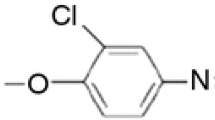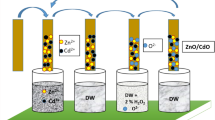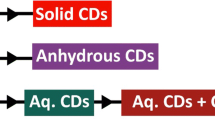Abstract
This study comes to complete the initial investigation of the liquid crystalline properties of 4-[(4-chlorobenzyl)oxy]-3,4′-dichloroazobenzene (CODA). Here, the thermal analysis of CODA dye was performed in air flow and nitrogen flow atmospheres by means of simultaneous thermogravimetry TG, derivative thermogravimetry DTG, differential thermal analysis DTA and differential scanning calorimetry DSC; differences between the two steps of the thermal degradation of CODA related to the two experimental atmospheres were observed. Drops cast and spin coating techniques were used for nanostructuring CODA on platinum (Pt) substrates; the deposited materials were characterised by atomic force microscopy (AFM) and scanning electron microscopy (SEM). Exotic crystalline nanowires of CODA were obtained as function of used deposition technique, while the deposition time decisively influenced their features. The present results advocate for employing these materials as template matrices for producing high-aspect-ratio inorganic nanomaterials (i.e. Au) in the form of nanotubes, nanowires, nanorods or nanoparticles with enhanced functional properties.










Similar content being viewed by others
References
Lu M, Cunningham BT, Park SJ, Eden JG. Vertically emitting, dye-doped polymer laser in the green (lambda similar to 536 nm) with a second order distributed feedback grating fabricated by replica molding. Opt Commun. 2008;281:3159–62.
He BQ, Liao Q, Huang Y. Random lasing in a dye doped cholesteric liquid crystal polymer solution. Opt Mater. 2008;31:375–9.
Fukuda M, Kodama K, Yamamoto H, Mito K. Evaluation of new organic pigments as laser-active media for solid-state dye laser. Dyes Pigments. 2004;63:115–25.
Eida M, Kuma H, Hosokawa C. Organic electroluminescent display and its production method. US Patent US20060012296 A1 2006.
Microyannidis JA, Tsagkournos DV, Sharma SS, Kumar A, Vijay YK, Sharma GD. Efficient bulk heterojunction solar cells based on low band gap bisazo dyes containing anthracene and/or pyrrole units. Solar Energy Mater Solar Cells. 2010;94:2318–27.
Yamaguchi T, Tobe N, Matsumoto D, Arakawa H. Highly efficient plastic substrate dye-sensitized solar cell using a compression method for preparation of TiO2 photoelectrodes. Chem Commun. 2007;45:4767–9.
Xu GR, Zhang YP, Li GB. Degradation of azo dye active brilliant red X-3B by composite ferrate solution. J Hazard Mater. 2009;161:1299–305.
Tucker JF. Sunglass lens laminate. US Patent US6102539 A 2000.
Holme I. Recent developments in colorants for textile applications. Surf Coat Int B Coat Trans. 2002;85:243–64.
Abel AG. Pigments for paint. In: Lambourne R, Strivens TA, editors. Paint and surface coatings: theory and practice. Cambridge: Woodhead Publishing Cambridge; 1999. p. 91–165.
Karci F, Sener N, Yamac M, Sener I, Demircali A. The synthesis, antimicrobial activity and absorption characteristics of some novel heterocyclic disazo dyes. Dyes Pigments. 2009;80:47–52.
Ozturk A, Abdullah MI. Toxicological effect of indole and its azo dye derivatives on some microorganisms under aerobic conditions. Sci Total Environ. 2006;358:137–42.
Liu S, Ma J, Zhao D. Synthesis and characterization of cationic monoazo dyes in corporating quaternary ammonium salts. Dyes Pigments. 2007;75:255–62.
Seferoglu Z, Ertan N, Yilmaz E, Uraz G. Synthesis, spectral characterisation and antimicrobial activity of new disazo dyes derived from heterocyclic coupling components. Coloration Technol. 2008;124:27–35.
Barbera J, Giorgini L, Paris F, Salatelli E, Tejedor RM, Angiolini L. Supramolecular chirality and reversible chiroptical switching in new chiral liquid-crystal azopolymers. Chem Eur J. 2008;14(35):11209–21.
White DL, Taylor GN. New absorptive mode reflective liquid-crystal display device. J Appl Phys. 1974;45:4718.
Benmouna R, Benyoucef B. Thermophysical and thermomechanical properties of Norland Optical Adhesives and liquid crystal composites. J Appl Polym Sci. 2008;108(6):4072–9.
Radu S, Sarpe-Tudoran C, Jianu A, Rau G. Aromatic azomonoethers as new organic materials for nonlinear optics. Rev Roum Chim. 1998;43:735–9.
Akiyama H, Kawara T, Takada H, Takatsu H, Chigrinov V, Prudnikova E, Kozenkov V, Kwok H. Synthesis and properties of azo dye aligning layers for liquid crystal cells. Liq Cryst. 2002;29:1321–7.
Moanta A, Rau G, Radu S. Studiul proprietăţilor spectrale şi determinarea activităţii biologice pentru o serie de 4-[(4-clorobenzil)oxi]-azobenzeni. Rev Chim (Bucureşti). 2007;58:229–31.
Moanta A, Ionescu C, Rotaru P, Socaciu M, Harabor A. Structural characterization, thermal investigation, and liquid crystalline behavior of 4-[(4-chlorobenzyl) oxy]-3, 4′-dichloroazobenzene. J Therm Anal Calorim. 2010;102:1079–86.
Camacho-Lopez M, Finkelmann H, Palffy-Muhoray P, Shelley M. Fast liquid-crystal elastomer swims into the dark. Nat Mater. 2004;3:307–10.
Jelinek M, Kocourek T, Remsa J, Cristescu R, Mihailescu IN, Chrisey DB. MAPLE applications in studying organic thin films. Laser Phys. 2007;17:66–70.
Rotaru A, Constantinescu C, Rotaru P, Moanţă A, Dumitru M, Socaciu M, Dinescu M, Segal E. Thermal analysis and thin films deposition by matrix assisted pulsed laser evaporation of a 4CN type azomonoether. J Therm Anal Calorim. 2008;92:279–84.
Matei A, Constantinescu C, Mitu B, Filipescu M, Ion V, Ionita I, Brajnicov S, Alloncle AP, Delaporte P, Emandi A, Dinescu M. Laser printing of azo-derivative thin films for non-linear optical applications. Appl Surf Sci. 2015;336:200–5.
Constantinescu C, Matei A, Ionita I, Ion V, Marascu V, Dinescu M, Vasiliu C, Emandi A. Azo-derivatives thin films grown by matrix-assisted pulsed laser evaporation for non-linear optical applications. Appl Surf Sci. 2013;302:69–73.
Constantinescu C, Emandi A, Vasiliu C, Negrila C, Logofatu C, Cotarlan C, Lazarescu M. Thin films of Cu(II)-o, o′-dihydroxy azobenzene nanoparticle-embedded polyacrylic acid (PAA) for nonlinear optical applications developed by matrix assisted pulsed laser evaporation (MAPLE). Appl Surf Sci. 2009;255:5480–5.
Constantinescu C, Morintale E, Emandi A, Dinescu M, Rotaru P. Thin films of Cu(II)-o, o′-dihydroxy azobenzene nanoparticle-embedded polyacrylic acid (PAA) for nonlinear optical applications developed by matrix assisted pulsed laser evaporation (MAPLE). Appl Surf Sci. 2009;255:5480–5.
Prasad LG. Azo dye doped polymer films for nonlinear optical applications. Chin J Polym Sci. 2014;32:650–7.
Chaplanova ZD, Muranski AA, Rogachev AA, Agabekov VE, Gracheva EA. Multi-layered anisotropic films based on the azo dye brilliant yellow and organic polymers. J Appl Spectrosc. 2013;80:658–62.
Rivera E, del Pilar Carreon-Castro M, Rodriguez L, Cedillo G, Fomine S, Morales-Saavedra OG. Amphiphilic azo-dyes (RED-PEGM) part 2: charge transfer complexes, preparation of Langmuir–Blodgett films and optical properties. Dyes Pigments. 2007;74:396–403.
Dobbelin M, Ciesielski A, Haar S, Osella S, Bruna M, Minoia A, Grisanti L, Mosciatti T, Richard F, Prasetyanto FA, De Cola L, Palermo V, Mazzaro R, Morandi V, Lazzaroni R, Ferrari AC, Beljonne D, Samori P. Light-enhanced liquid-phase exfoliation and current photoswitching in graphene–azobenzene composites. Nat Commun. 2016;. doi:10.1038/ncomms11090.
Briseno AL, Mannsfled SCB, Formo E, Xiong Y, Lu X, Bao Z, Jenekhe SA, Xia Y. Adding new functions to organic semiconductor nanowires by assembling metal nanoparticles onto their surfaces. J Mater Chem. 2008;18:5395–8.
Mizuguchi J. Correlation between crystal and electronic structures in diketopyrrolopyrrole pigments as viewed from exciton coupling effects. J Phys Chem A. 2000;104:1817–21.
Hoki T, Takahashi H, Suzuki S, Mizuguchi J. Hydrogen gas sensor based upon proton acceptors integrated in copper-tetra-2, 3-pyridinoporphyradine. IEEE Sensors J. 2007;7:808–13.
Beyerlein T, Tieke B, Forero-Lenger S, Brutting W. Red electroluminescence from a 1, 4-diketopyrrolo[3, 4-c]pyrrole (DPP)-based conjugated polymer. Synth Metals. 2002;130:115–9.
Potrawa T, Langhals H. Fluorescent dyes with large stokes shifts-soluble dihydropyrrolopyrrolediones. Chem Berichte. 1987;120:1075–8.
Lunak S, Vynuchal J, Vala M, Havel L, Hrdina R. The synthesis, absorption and fluorescence of polar diketo-pyrrolo-pyrroles. Dyes Pigments. 2009;82:102–8.
David J, Weiter M, Vala M, Vynuchal J, Kucerik J. Stability and structural aspects of diketopyrrolopyrrole pigment and its N-alkyl derivatives. Dyes Pigments. 2011;89:137–43.
Vala M, Vynuchal J, Toman P, Weiter M, Lunak S Jr. Novel, soluble diphenyl-diketo-pyrrolopyrroles: experimental and theoretical study. Dyes Pigments. 2010;84:176–82.
Weiter M, Salyk O, Bednar P, Vala M, Navratil J, Zmeskal O, Vynuchal J, Lunak S Jr. Morphology and properties of thin films of diketopyrrolopyrrole derivatives. Mat Sci Eng B. 2009;165:148–52.
Vala M, Weiter M, Vynuchal J, Toman P, Lunak S Jr. Comparative studies of diphenyl-diketo-pyrrolopyrrole derivatives for electroluminiscence applications. J Fluoresc. 2008;18:1181–5.
Kucerik J, David J, Weiter M, Vala M, Vynuchal J, Ouzzane I, Salyk O. Stability and physical structure test of piperidyl and morpholinyl derivatives of diphenyl-diketo-pyrrolopyrroles (DPP). J Therm Anal Calorim. 2012;108:467–73.
Pham VP, Galstyan T, Granger A, Lessard RA. Azo dye-doped poly(methyl methacrylate) films as optical data storage media. Jpn J Appl Phys. 1997;36:429.
Natansohn A, Rochon P, Gosselin J, Xie S. Azo polymers for reversible optical storage. 1. Poly [4′-[[2-(acryloyloxy) ethyl] ethylamino]-4-nitroazobenzene]. Macromolecules. 1992;25:2268–73.
Ho M-S, Natanshon A, Rochon P. Azo polymers for reversible optical storage. 7. The effect of the size of the photochromic groups. Macromolecules. 1995;28:6124–7.
IUPAC. Compendium of chemical terminology. 2nd ed. (the “Gold Book”) (1997). Online corrected version: 2009.
Rotaru A, Brătulescu G, Rotaru P. Thermal analysis of azoic dyes; part I. Non-isothermal decomposition kinetics of [4-(4-chlorobenzyloxy)-3-methylphenyl](p-tolyl)diazene in dynamic air atmosphere. Thermochim Acta. 2009;489:63–9.
Rotaru A, Constantinescu C, Mandruleanu A, Rotaru P, Moldovan A, Gyoryova K, Dinescu M, Balek V. Thermochim Acta. 2010;498:81–91.
Ahlstrom LH, Sparr Eskilsson C, Bjorklund E. Determination of banned azo dyes in consumer goods. Trends Anal Chem. 2005;24:49–56.
Golka K, Kopps S, Myslak ZW. Carcinogenicity of azo colorants: influence of solubility and bioavailability. Toxicol Lett. 2004;151:203–10.
Puntener A, Page C. European Ban on certain azo dyes. Quality Environ. 2004;1–3.
Gur M, Kocaokutgen H, Tas M. Synthesis, spectral, and thermal characterisations of some azo-ester derivatives containing a 4-acryloyloxy group. Dyes Pigments. 2007;72(1):101–8.
Badea M, Emandi A, Marinescu D, Cristurean E, Olar R, Braileanu A, Budrugeac P, Segal E. Thermal stability of some azo-derivatives and their complexes—1-(2-benzothiazolyl)-3-methyl-4-azo-pyrazil-5-one derivatives and their Cu(II) complexes. J Therm Anal Cal. 2003;72(2):525–31.
Dincalp H, Toker F, Durucasu J, Avcibasi N, Icli S. New thiophene-based azo ligands containing azo methine group in the main chain for the determination of copper(II) ions. Dyes Pigments. 2007;75(1):11–24.
Chen Z, Wu Y, Gu D, Gan F. Nickel(II) and copper(II) complexes containing 2-(2-(5-substitued isoxazol-3-yl)hydrazono)-5,5-dimethylcyclohexane-1,3-dione ligands: synthesis, spectral and thermal characterizations. Dyes Pigments. 2008;76(3):624–31.
Rotaru A, Moanţă A, Sălăgeanu I, Budrugeac P, Segal E. Thermal decomposition kinetics of some aromatic azomonoethers. Part I. Decomposition of 4-[(4-chlorobenzyl)oxy]-4′-nitro-azobenzene. J Therm Anal Cal. 2007;87(2):395–400.
Rotaru A, Kropidłowska A, Moanţă A, Rotaru P, Segal E. Thermal decomposition kinetics of some aromatic azomonoethers. Part II. Non-isothermal study of three liquid crystals in dynamic air atmosphere. J Therm Anal Cal. 2008;92(1):233–8.
Rotaru A, Moanţă A, Rotaru P, Segal E. Thermal decomposition kinetics of some aromatic azomonoethers. Part III. Non-isothermal study of 4-[(4-chlorobenzyl)oxy]-4′-chloro-azobenzene in dynamic air atmosphere. J Therm Anal Cal. 2009;95(1):161–6.
Rotaru A, Moanţă A, Popa G, Rotaru P, Segal E. Thermal decomposition kinetics of some aromatic azomonoethers. Part IV. Non-isothermal kinetics of 2-allyl-4-((4-(4-methylbenzyloxy) phenyl)diazenyl) phenol in dynamic air atmosphere. J Therm Anal Cal. 2009;97(2):485–91.
Rotaru A, Jurca B, Moanţă A, Sălăgeanu I, Segal E. Kinetic study of thermal decomposition of some aromatic ortho-chlorinated azomonoethers. 1. Decomposition of 4[(2-chlorobenzyl)oxi]-4′-trifluoromethyl-azobenzene. Rev Roum Chim. 2006;51(5):373–8.
Vala M, Weiter M, Heinrichova P, Sedina M, Ouzzane I, Moziskova P. Tailoring of molecular materials for organic electronics. J Biochem Tech. 2010;2:S44–5.
Zhang C, Yan Y, Zhao YS, Yao J. Synthesis and applications of organic nanorods, nanowires and nanotubes. Annu Rep Prog Chem Sect C: Phys Chem. 2013;109:211–39.
Garcia-Frutos EM. Small organic single-crystalline one-dimensional micro- and nanostructures for miniaturized devices. J Mater Chem C. 2013;1:3633–45.
Robello DR. Linear polymers for nonlinear optics. I Polyacrylates bearing aminoitro-stilbene and—azobenzene dyes. J Polym Sci, Part A: Polym Chem. 1990;28:1–13.
Campbell D, Dix LR, Rostron P. Liquid crystalline behaviour of azobenzene dyes. Dyes Pigments. 1995;29:77–83.
Ozdilek C, Toppare L, Yagci Y, Hacaloglu J. Characterization of polypyrrole/polytetrahydrofuran graft copolymers by direct pyrolysis mass spectrometry. J Anal Appl Pyrol. 2002;64:363–78.
Gilland JC, Lewis JS. Mass-spectroscopy of 4-amino-4′nitro-azobenzene compounds. Org Mass Spectrom. 1974;9:1148–53.
Messmer K, Nuyken O. Mass spectroscopic investigation of azo-compounds. 1. Org Mass Spectrom. 1977;12:100–5.
Radu S. Electron impact mass spectrometry of aromatic azoe thers. Eur Mass Spectrom. 1995;1:561–72.
Moanta A, Radu S. New phenoxyacetic acid analogues with antimicrobial activity. Rev Chim. 2008;59:708–11.
Moanta A, Radu S. Spectroscopic analysis and antimicrobial activity of some 4-phenylazo-phenoxyacetic acids. Rev Roum Chim. 2009;54:151–6.
Bratulescu G. Mass spectra of aromatic azoethers and azoxyethers. Rev Roum Chim. 2000;45:277–83.
Korolev VA, Nefedov OM. matrix infrared spectroscopy of intermediates with low coordinated carbon, silicon and germanium atoms. In: Bethell R, editor. Advances in physical organic chemistry. London: Academic Press, Harcourt Brace & Company; 1995.
Bognitzki M, Becker M, Graeser M, Massa W, Wendorff JH, Schaper A, Weber D, Beyer A, Golzhauser A, Greiner A. Preparation of sub-micrometer copper fibers via electrospinning. Adv Mater. 2006;18:2384–6.
Abel B, Coskun S, Mohammed M, Williams R, Unalan HE, Aslan K. Metal-enhanced fluorescence from silver nanowires with high aspect ratio on glass slides for biosensing applications. J Phys Chem C. 2015;119:675–84.
Gries K, Vieker H, Golzhauser A, Agarwal S, Greiner A. Preparation of continuous gold nanowires by electrospinning of high-concentration aqueous dispersions of gold nanoparticles. Small. 2012;8:1436–41.
Karusso RA, Schattka JH, Greiner A. Titanium dioxide tubes from sol–gel coating of electrospun polymer fibers. Adv Mater. 2001;13:1577–9.
Kriha O, Goring P, Milbradt M, Agarwal S, Steinhart M, Wehrspohn R, Wendorff JH, Greiner A. Polymer tubes with longitudinal composition gradient by face-to-face wetting. Chem Mater. 2008;20:1076–81.
Allwright E, Berg DM, Djemour R, Steichen M, Dale PJ, Robertson N. Electrochemical deposition as a unique solution processing method for insoluble organic optoelectronic materials. J Mat Chem C. 2014;2:7232–8.
Zhang F, Di C-A, Berdunov N, Hu Y, Hu Y, Gao X, Meng Q, Sirringhaus H, Zhu D. Ultrathin film organic transistors: precise control of semiconductor thickness via spin-coating. Adv Mater. 2013;25:1401–7.
Shen S, Jiang P, He C, Zhang J, Shen P, Zhang Y, Yi Y, Zhang Z, Li Z, Li Y. Solution-processable organic molecule photovoltaic materials with bithienyl-benzodithiophene central unit and indenedione end groups. Chem Mater. 2015;25:2274–81.
Pang J, Clark NA. Observation of a chiral-symmetry-breaking twist-bend instability in achiral freely suspended liquid-crystal films. Phys Rev Lett. 1994;73:2332–5.
Chan HK, Dierking I. Growth laws for the phase ordering dynamics of the B 1 phase of a bent-core liquid crystal. Phys Rev E. 2004;70:021703.
Haberl JM, Sanchez-Ferrer A, Mihut AM, Dietsch H, Hirt AM, Mezzenga R. Strain-induced macroscopic magnetic anisotropy from smectic liquid-crystalline elastomer–maghemite nanoparticle hybrid nanocomposites. Nanoscale. 2013;5:5539–48.
Ha ST, Koh TM, Lin HC, Yeap GY, Win YF, Ong ST, Sivasothy Y, Ong LK. Heterocyclic benzothiazole-based liquid crystals: synthesis and mesomorphic properties. Liq Cryst. 2009;36:917–25.
Cavallaro G, Lazzara G, Milioto S, Parisi F. Halloysite nanotubes as sustainable nanofiller for paper consolidation and protection. J Therm Anal Calorim. 2014;117:1293–8.
Cavallaro G, Lazzara G, Milioto S, Parisi F, Sanzillo V. Modified halloysite nanotubes: nanoarchitectures for enhancing the capture of oils from vapor and liquid phases. ACS Appl Mater Interfaces. 2014;6:606–12.
Cavallaro G, Lazzara G, Milioto S, Parisi F, Sparacino V. Thermal and dynamic mechanical properties of beeswax-halloysite nanocomposites for consolidating waterlogged archaeological woods. Polym Degrad Stab. 2015;120:220–5.
Gingery D, Buhlmann P. Formation of gold nanoparticles on multiwalled carbon nanotubes by thermal evaporation. Carbon. 2008;46:1966–72.
Kabashin AV, Meunier M, Kingston C, Luong JHT. Fabrication and characterization of gold nanoparticles by femtosecond laser ablation in an aqueous solution of cyclodextrins. J Phys Chem B. 2003;107:4527–31.
Date M, Okumura M, Tsubota S, Haruta M. Vital role of moisture in the catalytic activity of supported gold nanoparticles. Angew Chem. 2004;46(16):2129–32.
Maier SA, Brongersma ML, Kik PG, Meltzer S, Requicha AA, Atwater HA. Plasmonics—a route to nanoscale optical devices. Adv Mater. 2001;13:1501–5.
Acknowledgements
The authors would like to thank Dr. Anca Moanta (University of Craiova) for synthetising and providing the CODA material.
Author information
Authors and Affiliations
Corresponding author
Rights and permissions
About this article
Cite this article
Rotaru, A., Dumitru, M. Thermal behaviour of CODA azoic dye liquid crystal and nanostructuring by drop cast and spin coating techniques. J Therm Anal Calorim 127, 21–32 (2017). https://doi.org/10.1007/s10973-016-5599-z
Received:
Accepted:
Published:
Issue Date:
DOI: https://doi.org/10.1007/s10973-016-5599-z




